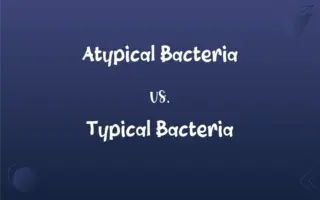CAMP Test vs. Reverse CAMP Test: What's the Difference?
Edited by Aimie Carlson || By Janet White || Published on February 6, 2024
CAMP Test is a biochemical test for identifying bacteria producing the CAMP factor, typically Streptococcus agalactiae. Reverse CAMP Test identifies bacteria inhibiting the CAMP factor, often used to differentiate Staphylococcus species.

Key Differences
The CAMP test is a biochemical assay used to identify the presence of CAMP factor, an extracellular protein produced by certain bacteria like Streptococcus agalactiae. The reverse CAMP test, in contrast, is used to detect bacteria that inhibit the CAMP factor, mainly to differentiate between species of Staphylococcus.
In the CAMP test, a streak of bacteria suspected of producing the CAMP factor is placed perpendicular to a streak of Staphylococcus aureus on a blood agar plate. In the reverse CAMP test, the roles are reversed; the test organism is streaked alongside a line of a known CAMP factor producer.
The CAMP test results are interpreted by the formation of an enhanced hemolysis area where the two bacterial streaks meet, indicating a positive result. In the reverse CAMP test, inhibition of hemolysis or a diminished hemolysis zone indicates a positive result.
The CAMP test is primarily used in clinical microbiology to identify Group B Streptococcus, which is an important pathogen in neonatal infections. The reverse CAMP test is useful in identifying certain Staphylococcus species, which have clinical significance in nosocomial infections.
Both tests are simple, cost-effective, and require minimal specialized equipment, making them accessible in most microbiology laboratories. However, their specificity and sensitivity can vary, and they are often used in conjunction with other diagnostic methods.
ADVERTISEMENT
Comparison Chart
Purpose
Identifies CAMP factor-producing bacteria
Detects bacteria that inhibit CAMP factor
Typical Use
Identifying Streptococcus agalactiae
Differentiating Staphylococcus species
Test Procedure
Streaking test bacteria perpendicular to S. aureus
Streaking test bacteria alongside CAMP factor producer
Positive Result
Enhanced hemolysis area
Inhibited or diminished hemolysis zone
Clinical Significance
Used for neonatal infection pathogens
Important for identifying nosocomial infection pathogens
ADVERTISEMENT
CAMP Test and Reverse CAMP Test Definitions
CAMP Test
A test for detecting bacteria that produce the CAMP factor.
The lab used the CAMP test to confirm the presence of Group B Streptococcus.
Reverse CAMP Test
Important for characterizing certain nosocomial pathogens.
The reverse CAMP test was essential in the hospital’s infection control program.
CAMP Test
A cost-effective method for bacterial pathogen detection.
Due to limited resources, the clinic relied on the CAMP test for initial screenings.
Reverse CAMP Test
Uses known CAMP factor producers to identify inhibitory bacteria.
In the reverse CAMP test, the lab used a Group B Streptococcus strain as a control.
CAMP Test
Identifies hemolytic activity enhanced by CAMP factor.
A positive CAMP test indicated increased hemolysis due to the CAMP factor.
Reverse CAMP Test
A test to identify bacteria inhibiting CAMP factor production.
The reverse CAMP test helped differentiate the Staphylococcus species in the sample.
CAMP Test
A simple assay using Staphylococcus aureus to screen for CAMP factor producers.
In the CAMP test, the interaction with S. aureus was crucial for accurate identification.
Reverse CAMP Test
A straightforward assay for Staphylococcus differentiation.
The microbiology team used the reverse CAMP test for quick pathogen identification.
CAMP Test
Used in clinical microbiology for specific bacterial identification.
The CAMP test was key in diagnosing the neonatal infection.
Reverse CAMP Test
Detects reduced hemolysis due to CAMP factor inhibition.
A positive reverse CAMP test was indicated by diminished hemolysis on the agar plate.
FAQs
What is the CAMP test?
A test for identifying CAMP factor-producing bacteria.
How is the CAMP test performed?
By streaking test bacteria perpendicular to a streak of S. aureus.
What does the reverse CAMP test do?
It identifies bacteria that inhibit CAMP factor production.
What is the clinical significance of the reverse CAMP test?
It's used to differentiate Staphylococcus species.
Is the CAMP test specific for Streptococcus agalactiae?
It's highly indicative but not exclusively specific.
How long does a CAMP test take to show results?
Typically, results are observed after overnight incubation.
Are there any limitations to the reverse CAMP test?
It may not differentiate between all Staphylococcus species.
Which bacteria is commonly identified by the CAMP test?
Group B Streptococcus (Streptococcus agalactiae).
What indicates a positive reverse CAMP test?
Inhibition or reduction of hemolysis around the streak.
What precautions are necessary when conducting the reverse CAMP test?
Standard laboratory safety and contamination prevention measures.
Can the reverse CAMP test identify other bacteria besides Staphylococcus?
Its primary use is for differentiating Staphylococcus species.
Can the reverse CAMP test be used for antibiotic susceptibility testing?
No, it's not designed for that purpose.
Is the reverse CAMP test reliable for hospital-acquired infection identification?
It's a useful tool but should be combined with other tests.
Are there any bacteria that give false positives in the reverse CAMP test?
Specificity issues can arise, but they are uncommon.
Can the CAMP test be used for environmental sampling?
It's primarily used for clinical samples.
What kind of samples can be tested with the CAMP test?
Clinical samples like swabs from infections.
How does the CAMP test contribute to neonatal care?
By helping diagnose infections caused by Group B Streptococcus.
Is a blood agar plate required for the CAMP test?
Yes, it's necessary for observing hemolysis.
Do both tests require specialized laboratory equipment?
They need basic microbiology lab equipment.
How cost-effective are the CAMP and reverse CAMP tests?
They are both considered affordable and cost-effective diagnostic methods.
About Author
Written by
Janet WhiteJanet White has been an esteemed writer and blogger for Difference Wiki. Holding a Master's degree in Science and Medical Journalism from the prestigious Boston University, she has consistently demonstrated her expertise and passion for her field. When she's not immersed in her work, Janet relishes her time exercising, delving into a good book, and cherishing moments with friends and family.
Edited by
Aimie CarlsonAimie Carlson, holding a master's degree in English literature, is a fervent English language enthusiast. She lends her writing talents to Difference Wiki, a prominent website that specializes in comparisons, offering readers insightful analyses that both captivate and inform.









































































